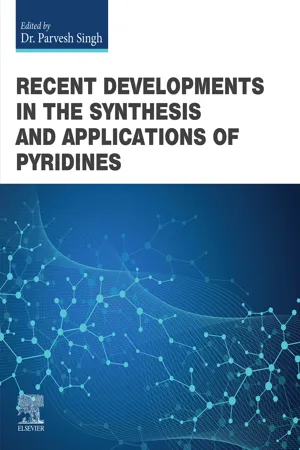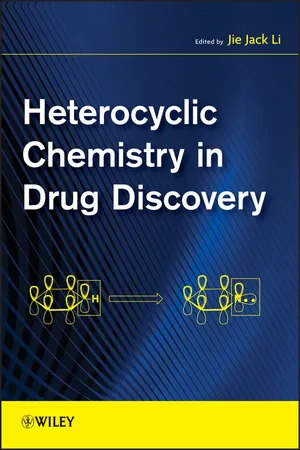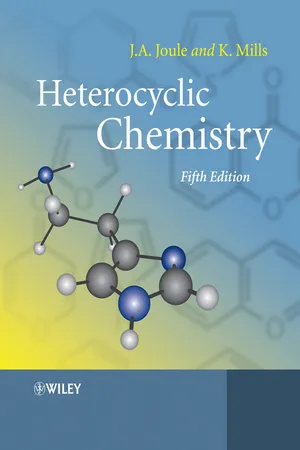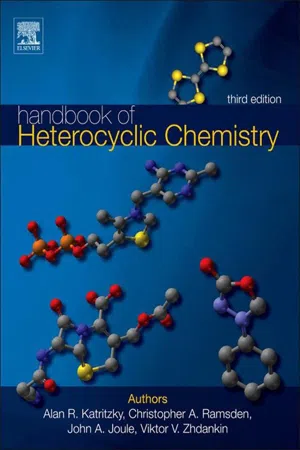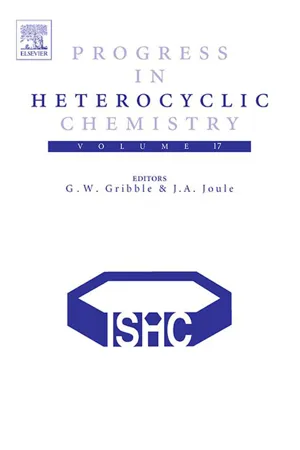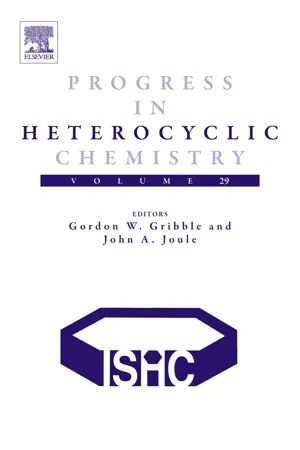Chemistry
Pyridine
Pyridine is a heterocyclic compound with a six-membered ring containing five carbon atoms and one nitrogen atom. It is a colorless liquid with a distinct, unpleasant odor and is commonly used as a solvent and reagent in organic synthesis. Pyridine is also found in various natural products and pharmaceuticals, and its derivatives have diverse applications in the chemical industry.
Written by Perlego with AI-assistance
8 Key excerpts on "Pyridine"
- Parvesh Singh(Author)
- 2022(Publication Date)
- Elsevier(Publisher)
Its cyclic nature was recognized by Dewar and Korner in 1869 [8]. Pyridine and its related derivatives are a privileged class of heterocyclic compounds found in various chemotherapeutic agents [ 9, 10 ]. Pyridine is widely found in many natural products such as vitamins, alkaloids and coenzymes and forms the nucleus of around 253 FDA-approved drugs. Pyridine-based compounds are known to possess a remarkable biological and pharmacological activity including antimicrobial [11], antimalarial [12], anticancer [13], HIV inhibitors [14], antioxidant [15], and many others [16]. Pyridine moieties are frequently used in drugs due to their characteristics such as stability, water solubility, basicity, hydrogen bond-forming capacity, and small molecular size, which help to improve pharmacokinetic, pharmacological, and physicochemical properties. The effective therapeutic behavior of Pyridines in drug discovery is mainly based on their mimicking nature. Pyridine ring acts as bioisostere of benzene, amines, amides, and other nitrogen-containing heterocycles. Pyridine is aromatic and possesses six delocalized electrons in the ring (Fig. 12.1). The nitrogen's lone electron pair of Pyridine occupies sp 2 orbital parallel to the ring plane. Therefore, this electron pair does not participate in the aromatic π-system ring and more available for donation. In comparison to benzene, Pyridine is an electron deficient and polar molecule due to the electron-withdrawing effect of the highly electronegative nitrogen atom. The electron density in Pyridine ring at the C-2, C-4, and C-6 positions is less than that at the C-3 and C-5 positions. Therefore, Pyridine has a dipole moment and a weaker resonant stabilization than benzene- eBook - ePub
- Jie Jack Li, Jie Jack Li(Authors)
- 2013(Publication Date)
- Wiley(Publisher)
PART III
SIX-MEMBERED HETEROCYCLES WITH ONE HETEROATOM
Chapter 10 Pyridines Chapter 11 Quinolines and IsoquinolinesPassage contains an image
Chapter 10
Pyridines
Jennifer Xiaoxin Qiao10.1 Introduction
Pyridine is a flammable, colorless, and relatively stable and unreactive liquid with a characteristic pungent, unpleasant odor. Anhydrous Pyridine has a boiling point of 115 °C and a density of 0.9819 g/cm3 . Pyridine is miscible with water and virtually all organic solvents. It is weakly basic, and with hydrochloric acid it forms a crystalline hydrochloride salt, which melts at 145–147 °C. Pyridine was first isolated from bone pyrolysates. Its name was derived from the Greek for fire “pyr” and the suffix “idine” was used to designate aromatic bases. Pyridine is also used as a solvent, and its derivatives have been used as pharmaceuticals, vitamins, food flavorings, paints, dyes, rubber products, adhesives, insecticides, and herbicides, etc.1 Pyridine can also be formed from the breakdown of many natural materials in the environment.Pyridine, with 6π-electrons, is an electron-deficient aromatic heterocycle containing a ring nitrogen atom. The aromatic π-electron system does not require the participation of the lone pair of electrons on the nitrogen atom. The ring nitrogen is more electronegative than the ring carbons, making the two α-ring carbons and γ-ring carbon more electropositive than otherwise would be expected from benzene (see the natural atomic charges of Pyridine and benzene calculated at RHF//6-31G** ). The resonance structures and the natural atomic charges of Pyridine predict its electron-deficient nature and rationalize its much higher dipole moment relative to benzene, which is mainly responsible for the higher boiling point (115 vs. 80 °C) and high water solubility of Pyridine.Consequently, Pyridine has a reduced susceptibility to electrophilic substitution compared to benzene, while being more susceptible to nucleophilic attack. One unique aspect of Pyridine is the protonation, alkylation, and acylation of its nitrogen atom. The resultant salts are still aromatic, however, and they are much more polarized. Details for reactivity of Pyridine derivatives, in particular, reactions on the Pyridine nitrogen and the Zincke reaction, as well as C - eBook - ePub
- John A. Joule, Keith Mills(Authors)
- 2013(Publication Date)
- Wiley-Blackwell(Publisher)
8
Pyridines: Reactions and Synthesis
Pyridine and its simple derivatives are stable and relatively unreactive liquids, with strong penetrating odours that are unpleasant to some people. They are much used as solvents and bases, especially Pyridine itself, in reactions such as N - and O -acylation and -tosylation. Pyridine and the three monomethyl Pyridines (picolines) are completely miscible with water.Pyridine was first isolated, like pyrrole, from bone pyrolysates: the name is constructed from the Greek for fire, ‘pyr’, and the suffix ‘idine’, which was at the time being used for all aromatic bases – phenetidine, toluidine, etc. Pyridine and its simple alkyl derivatives were for a long time produced by isolation from coal tar, in which they occur in quantity. In recent years this source has been displaced by synthetic processes: Pyridine itself, for example, can be produced on a commercial scale in 60–70% yields by the gas-phase high-temperature interaction of crotonaldehyde, formaldehyde, steam, air and ammonia over a silica–alumina catalyst. Processes for the manufacture of alkyl-Pyridines involve reaction of acetylenes and nitriles over a cobalt catalyst.8.1 Reactions with Electrophilic Reagents
8.1.1 Addition to Nitrogen
In reactions that involve bond formation using the lone pair of electrons on the ring nitrogen, such as protonation and quaternisation, Pyridines behave just like tertiary aliphatic or aromatic amines. When a Pyridine reacts as a base or a nucleophile it forms a ‘pyridinium’, cation in which the aromatic sextet is retained and the nitrogen acquires a formal positive charge.8.1.1.1 Protonation of Nitrogen
Pyridines form crystalline, frequently hygroscopic, salts with most protic acids. Pyridine itself, with pK aH 5.2 in water, is a much weaker base than saturated aliphatic amines which have pK aH values mostly between 9 and 11. Since the gas-phase proton affinity of Pyridine is actually very similar to those of aliphatic amines, the observed solution values reflect relatively strong solvation of aliphatic ammonium cations;1 this difference may in turn be related to the mesomerically delocalised charge in pyridinium ions and the consequent reduced requirement for external stabilisation via - eBook - ePub
Palladium in Heterocyclic Chemistry
A Guide for the Synthetic Chemist
- Jie Jack Li, Gordon Gribble(Authors)
- 2006(Publication Date)
- Elsevier Science(Publisher)
Chapter 4Pyridines
Paul GalatsisPyridine was first isolated, like pyrrole, from bone pyrolysates. Its name is derived from the Greek for fire (pyr) and the suffix “idine” used to designate aromatic bases. Pyridine can also be formed from the breakdown of many natural materials in the environment. Pyridine is used as a solvent, in addition to many other uses including products such as pharmaceuticals, vitamins, food flavorings, paints, dyes, rubber products, adhesives, insecticides, and herbicides. Structurally, Pyridine derivatives can range in complexity from the relatively simple monosubstituted Pyridine, nicotine (1 ), to the highly elaborated sesquiterpene Pyridine alkaloids, chuchuhuanines [1 ] (2 ).The transformation of benzene to Pyridine (Fig. 4.1 ) by the seemingly straightforward exchange of a CH group for N, allows retention of aromaticity in the six-membered ring, but has a dramatic change on the chemistry of Pyridine when compared to that of benzene.Figure 4.1Pyridine is the prototypical electron-poor six-membered ring heterocycle. The aromaticity originally found in the benzene framework is maintained in Pyridine via overlap with the unhybridized p orbital found on the sp2 hybridized nitrogen atom that is parallel to the π-system of the carbon framework. The resonance pictures, as well as, the natural atomic charges of Pyridine (Fig. 4.2 ), predict its electron deficient nature.Figure 4.2The consequence of this replacement gives Pyridine a reduced susceptibility to electrophilic substitution compared to benzene, while being more susceptible to nucleophilic attack. An avenue of chemistry not possible with benzene is the formation of pyridinium salts by donation of the nitrogen lone pair electrons. The resultant salts are still aromatic, however they are much more polarized. This is reflected by the apparent acidity of the corresponding conjugate acid (pKa 5.2) compared to the acidity of the corresponding conjugate acid of piperidine (pKa - eBook - ePub
New Frontiers in Nanochemistry: Concepts, Theories, and Trends
Volume 1: Structural Nanochemistry
- Mihai V. Putz, Mihai V. Putz(Authors)
- 2020(Publication Date)
- Apple Academic Press(Publisher)
CHAPTER 41Pyrimidines
NICOLETA A. DUDAŞ and MIHAI V. PUTZ
Laboratory of Computational and Structural Physical Chemistry for Nanosciences and QSAR, Biology-Chemistry Department, West University of Timişoara, Pestalozzi Str. No. 16, Timişoara 300115, Romania, E-mails: [email protected] , [email protected] , [email protected]41.1 DEFINITION
Pyrimidines (1,3-diazines or m-diazines) are one of three classes of six-membered heterocyclic aromatic compounds containing two nitrogen atoms in their ring, the other two diazines being pyridazines (1,2-diazines) and pyrazines (1,4-diazines). The pyrimidine ring is the basic structural element of nitrogenous bases of DNA and RNA, is one of the most widespread heterocyclic in various biologically important derivatives, as substituted derivatives and ring-fused compounds.Pyrimidine derivatives are utilized as drugs in the treatment of several types of diseases, agrochemicals, chromophores, complexes, metal sensors, solar cells technology, etc. Pyrimidines can be obtained by the synthetic chemical route, from biosynthesis (metabolism ↔ catabolism) and also in prebiotic condition.Because the pyrimidine ring contains two nitrogen atoms it has a weakly basic character, pyrimidine systems are highly electron deficient, and that is why electrophilic aromatic substitution gets more difficult, while nucleophilic aromatic substitution gets easier.41.2 HISTORICAL ORIGIN(S)
The first pyrimidinic compounds that were discovered are alloxan – 1818, guanine – 1844, barbituric acid – 1864, cytosine – 1894, uracil – 1900, and in 1899 was first synthesized unsubstituted pyrimidine (Figure 41.1 ) (Brown et al., 1994; Harris & Thimann, 1949; Grimaux, 1879; Fischer, 1897; Kossel & Steudel, 1903; Gabriel & Colman, 1899; Baeyer, 1864). The first simple pyrimidine derivatives that have been extracted from natural sources are vicine and convicine in 1870 from Vicia sativa and Vicia faba L - eBook - ePub
- Gordon Gribble, J. Joule(Authors)
- 2005(Publication Date)
- Elsevier Science(Publisher)
Chapter 6.1Six-membered ring systems: Pyridines and benzo derivatives
Heidi L. Fraser [email protected] ; M. Brawner Floyd [email protected] Chemical and Screening Sciences, Wyeth Research, Pearl River, NY, USAAna C. Barrios Sosa [email protected] Pharmaceutical Process Development, Roche Carolina Inc., Florence, SC, USA6.1.1 INTRODUCTION
Pyridines and their benzo-derivatives have received considerable synthetic attention for a variety of reasons. They are key scaffolds in biologically active and naturally occurring substances; moreover, they have become important ligands for organometallic chemistry and material science. Two reviews published in 2004 illustrate the broad application of Pyridines. The first focuses on 2,2’-biPyridines as functional nanomaterials <04EJO235 > and the second describes the use of chiral Pyridine N -oxides as ligands for asymmetric catalysis <04TA1373 >. Additional reviews on the chemistry of Pyridines published in 2004 include Henry’s review on de novo synthesis of Pyridines <04T6043 > and Lavilla’s review on the chemistry of dihydroPyridines and pyridinium salts <04CORC715 >. This review includes a summary of the methods developed for the syntheses and reactions of Pyridines, quinolines, isoquinolines, and piperidines that were disclosed in the literature in 2004. This chapter covers selected advances in the field and will serve an update to the review published last year in this volume.6.1.2 PyridineS
6.1.2.1 Preparation of Pyridines
Asokan et al. has developed a practical synthesis of 4-chloroPyridines 1 from carbonyl compounds having two enolizable carbons adjacent to the carbonyl such as compound 2 <04T5069 >. Ketone 2 was subjected to Vilsmeier-Haack reaction conditions leading to the formation of conjugated iminium salts 3 , which upon reacting with ammonium acetate cyclized to form the 4-chloroPyridines 1 - eBook - ePub
- Gordon Gribble, John A. Joule(Authors)
- 2017(Publication Date)
- Elsevier(Publisher)
Chapter 6.1Six-Membered Ring Systems
Pyridine and Benzo Derivatives
Tara L.S. Kishbaugh1 and Katherine Lehman Eastern Mennonite University, Harrisonburg, VA, United States 1 Corresponding author: E-mail: [email protected]Abstract
The Pyridine scaffold is present in a number of natural products, biologically active materials, as well as in materials with interesting physical–chemical properties. As such, their preparation and properties continue to be ubiquitously examined. Several reviews point to interesting approaches to the Pyridine core as well as metal-free approaches to quinolines.While this review cannot exhaustively cover the advances made in the field during 2016, it will describe newly characterized natural products and summarize key approaches to Pyridine, quinolines, and isoquinolines as well as highlight some of the ways in which these systems have been derivatized recently.Keywords
(Iso)quinoline; 1-Benzazepines; AminoPyridine; Anthranils; Cycloaddition; Intramolecular acylcyanation; Pyridine; Sonogashira coupling6.1.1. Introduction
The Pyridine scaffold is present in a number of natural products, biologically active materials, as well as in materials with interesting physical–chemical properties. As such, their preparation and properties continue to be ubiquitously examined. Several reviews point to interesting approaches to the Pyridine core (16Mol660 ) as well as metal-free approaches to quinolines (16Mol986 ).6.1.2. Pyridine and (Iso)quinoline Natural Products
While the numbers of new Pyridine-containing natural products may be small, there have been a number of unique additions. For example, the pyristriatins (Fig. 1 , right) are the first cyathane natural products featuring a Pyridine ring (16JNP1684 ). Pyristriatins A and B, along with a striatin C, were isolated from cultures of Cyathus cf. striatus - eBook - ePub
- John A. Joule(Author)
- 2020(Publication Date)
- CRC Press(Publisher)
2111,2,4-Triazines, acting as inverse electron demand dienes, add to enamines, and following extrusion of nitrogen and loss of amine, a Pyridine is produced (section 25.2.1 ).212The Ο,Ο′-bis-t-butyldimethylsilyl derivative of an imide serves as an azadiene in reaction with dienophiles; 2-pyridones are the result, following desilylation.2135.15.1.5 From furans
2-Furfurylamines can be converted via ring-opening ring-closure sequences, for example through 2,5-dimethoxy-2,5-dihydrofurans, into 3-hydroxyPyridines.Ring-opening and reclosure processes using furans include several significant methods for the construction of Pyridines. 2,5-Dihydro-2,5-dimethoxyfurans (see section 15.1.4 ) carrying as side-chain an aminoalkyl group, give rise to 3-hydroxyPyridines.214Furfurylamines react with formaldehyde, directly,215 (or with an aromatic aldehyde via 5-lithiation after N-protection216 ) to give 3-hydroxy-6-substituted Pyridines.5.15.1.6 Miscellaneous methods
Many alkylPyridines are manufactured commercially by chemically complex processes which often produce them as mixtures. A good example is the extraordinary Chichibabin synthesis, in which paraldehyde and ammonium hydroxide react together at 230°C under pressure to afford 52% of 5-ethyl-2-methylPyridine; so here, four mol equivalents of acetaldehyde and one of ammonia combine.217 Also of commercial significance is the cobalt-catalysed interaction of a nitrile and acetylene.2185.15.2 Examples of notable syntheses of Pyridine compounds
5.15.2.1 Fusarinic acid
Fusarinic acid is a mould metabolite with antibiotic and antihypertensive activity. Two syntheses of this substance employ cycloadditions, the earlier219 as a means to produce a 1,5-diketone, and the second220
Index pages curate the most relevant extracts from our library of academic textbooks. They’ve been created using an in-house natural language model (NLM), each adding context and meaning to key research topics.
Explore more topic indexes
Explore more topic indexes
1 of 6
Explore more topic indexes
1 of 4
